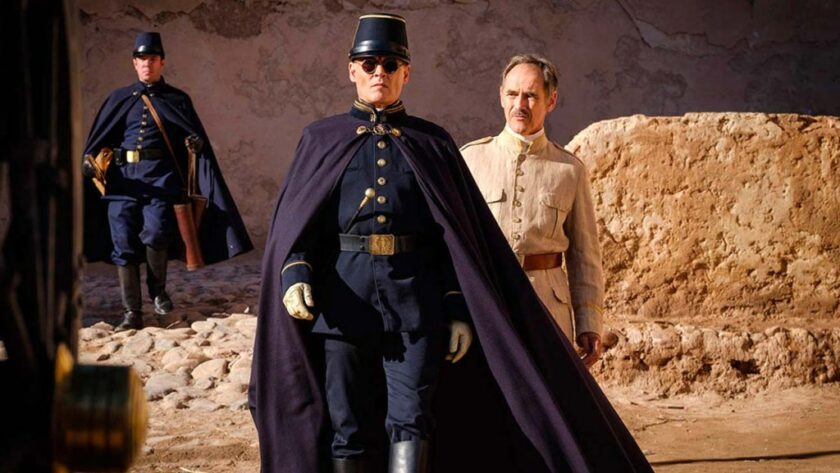Emma Davis reviews Ciro Guerra’s latest colonial drama.
Waiting for the Barbarians follows a man called the Magistrate (Mark Rylance) over the course of a full year running the outpost of a small frontier town situated in ‘The Empire’. The film starts with the torrid arrival of Colonel Joll (Johnny Depp), a cruel and efficient officer who has been sent to quell any indigenous peoples’ revolt against the Empire. The Magistrate works closely with the oppressive Colonel, which leads the Magistrate to question his loyalty to the Empire – an uncertainty that acts as a catalyst to his eventual downfall. Despite a colour palette reminiscent of the Adventures of Tintin comics, this film takes on a surprisingly dark and serious tone.
This is Colombian director Ciro Guerra’s fifth feature film and first English-language one. Waiting for the Barbarians bears similarity to the director’s Oscar-nominated Empress of the Serpent and his crime drama Birds of Passage, which both explore the tumultuous relationship between Colombian indigenous peoples and their oppressors. Extrapolated to a more general context, Waiting for the Barbarians centers the psyche of the coloniser, not the colonised. The script is penned by Afrikaner J. M. Coetzee, writer of the novel by the same name, who grew up in South Africa during apartheid. His best-known works are largely about people feeling like foreigners where they live—an idea that is explored with the Magistrate’s character in Waiting For The Barbarians.
Mark Rylance handles the character of the Magistrate astutely. His character is gentle yet strictly bureaucratic, a disposition nuanced by an obsession with the local people and culture. The audience feels unease as Rylance’s creepy performance and a strong script deftly handle issues of fetishization and the colonial gaze. The character of Colonel Joll serves as a great adversary to Ryland’s Magistrate. Johnny Depp plays the Colonel as cold, cruel, and deeply unsettling, a portrayal that avoids becoming a caricature thanks to the small amount of screen time given to his character. The body language and costume design of the Colonel juxtaposes that of the Magistrate, with the Colonel’s decadent black-and-gold uniform providing a stark contrast to the practical khaki clothing of the Magistrate. When the pair interact, their scenes reveal tension beneath the characters’ polite formalities.
The rest of the characters are not utilised as well as Rylance and Depp. As Officer Mandel, Robert Pattinson makes an excellent late entrance to the film, but the rest of his time on-screen feels indulgent and is used to demonstrate increasing brutality against revolutionary suspects. Aside from these three men, Gana Bayarsaikhan plays a woman from the ‘barbarian’ nomadic tribes, simply called The Girl. Tall and beautiful, with a tragic backstory and incredibly muddled storyline, she simply exists to further the narrative development of the Magistrate. This issue extends to the rest of the supporting cast; while they could be interesting figures in their own right, they simply prop up their protagonist.

The film plays with lots of ideas, but these ideas fail to impress. The whole movie feels dated, especially the tropes of colonial fiction used. The second half contains more physical violence than the first, exposing a greater depth of suffering to the Magistrate and, in turn, the audience. What pleasure would an audience receive from seeing a uniformed white man beating a row of Asian people? What do I, as a viewer, discover about human brutality by seeing women and children of colour being beaten? What can I learn about the tension between revolution and reform as forms of social justice? This movie portrays violence and suffering without actually delivering the substance it desperately wants to get across. Clunky narrative and weak thematic points let down an otherwise stylish film.
A modern audience would benefit from specific depictions of the injustices that speak truth to colonialism’s impact. For instance, I prefer the work of director Claire Denis in her cinematic explorations of the ‘white saviour’; compared to Denis’ filmography, Guerra’s direction and Coetzee’s writing look weak. Ava DuVernay’s series When They See Us takes the perspective of the victims of a wrongful conviction by New York Department of Justice. Any adaptation of Madame Butterfly will show how a white man in power falling for and seeking to protect a woman of colour in his imperial domain was a staple of 20th Century Asian representation. In literature, Nadine Gordimer puts nonwhite South Africans in the centre of her stories on apartheid South Africa, in contrast to J. M. Coetzee’s more limited scope. Gordimer is thus known for more politically-charged writing about apartheid South Africa than Coetzee (You can read about their debate on censorship around Salman Rushdie’s work here). When it comes to examining colonialism, I think it’s inappropriate to insist, as Waiting for the Barbarians does, on an almost fantastical setting when the costume design and colonial themes strongly invoke the very real memory of European violence. As such, exploring the perspective of the oppressor, no matter how sympathetic they are, is dangerous — and frankly, it’s boring.
The film explores the validity of indigenous peoples’ knowledge, and this produces the most compelling metaphor. As the Magistrate tells the newly-arrived colonial armed forces, the local people know the land better than the colonisers of the Empire. When suspects are apprehended by the armed forces, the violence is pointed: the indigenous captives’ eyes are ruined to blindness. They can no longer see the world around them or the land they live on. Their feet are burned, which also symbolically ruins the lifestyle of nomadic peoples: they are now deprived of the freedom to roam without subjugation and obedience to the Empire. But again, it is not particularly insightful to reap the suffering of people of colour on-screen when they are unnamed characters. In this film, they are reduced in the gaze of the Magistrate, their coloniser, as he questions his own allegiance to the Empire.
The inadequate handling of these narrative features distracts from the main cinematic elements of the film. No matter how well the cinematography serves the desert and mountains, or how intricate the costume design, the film’s analysis of colonialism feels strange amidst the realities of our modern discourse. It misses the mark on what kind of stories are needed today to discuss issues and repercussions of colonial regimes. Those in power have written their own history, and this film reinforces these narratives instead of directly confronting them.
Comparatively, Waiting for the Barbarians‘ attempt at commentary leaves audiences underwhelmed. The film clearly wants to be subversive—are the colonisers not the barbarians for their violence?—yet falls flat. The creative tools used to explore these ideas are employed awkwardly, making the stylistic and cinematic elements empty and the overall movie a drag. Whilst empire nostalgia is insidiously prevalent in European nations, I’m not sure to what audience this movie is meant to appeal.




